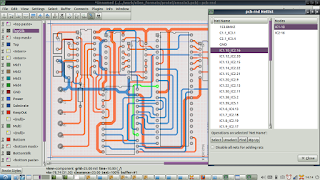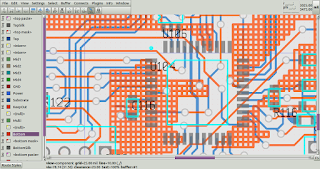Protel Autotrax and Protel Easytrax were industry standard DOS based PCB design tools in the early 1990s. Protel Easytrax was a cut down version of Protel Autotrax. The more capable Protel Autotrax required a dongle to operate.
Altium recently released Protel Autotrax as freeware, and it still has something of a following among those familiar with it who are happy to continue using it in a DOS emulator. Arguably, those with low end hardware in educational or hackerspace contexts may still find Protel Autotrax quite adequate for PCB design stations, particularly now that subsequent conversion to multiple formats is possible with pcb-rnd.
The import/export feature will primarily be of use to those seeking to:
- modify previously distributed Protel Autotrax and Easytrax designs in something other than the original Protel Autotrax software
- use legacy Protel Autotrax and Easytrax designs sourced from others to generate gerbers for fabrication
- export footprints and designs for existing Protel Autotrax users
- convert Protel Autotrax and Easytrax designs into any of the other formats supported by pcb-rnd, such as postscript, png, svg, gcode, XYRS, kicad legacy layouts, kicad s-expression layouts, etc...
- convert old footprints in Protel Autotrax and Easytrax designs for use in more modern tools.
Because Protel Autotrax and Easytrax only support rectangular polygonal copper pours, the exporter will export any complex, non-rectangular polygons in a design as an outline of the islands and holes, and cross hatch the interior.
Simple rectangular polygonal pours are however exported as standard Protel Autotrax/Easytrax rectangular "Free Fill" rectangles.
For lines, 90 degree arc segments, pads and pins, however, exporting to Protel Autotrax format will be essentially lossless, within the limitations of the 1 mil resolution of the Protel Autotrax/Easytrax format, and 90 degree quadrant arc support in the Protel Autotrax/Easytrax format
Protel Moiro Targets and Cross Hair targets are not supported on import.
Also, pins and vias with connection/clearance flags for the GND and POWER copper layers are not acted on. This will not be an issue for any designs which do not have dedicated GND and/or POWER copper layers.
"Multi" and "board" layer elements are combined with the top silk layer during import into pcb-rnd, as they are not explicitly supported as layer types in pcb-rnd.
"Keepout", which delineates the board outline and cutouts, is mapped to the outline layer in pcb-rnd.
For those keen to implement an importer for some other format, the io_autotrax code would serve as a good template for those keen to give rolling their own a go. Alternatively, if provided with sufficient, suitable examples and summary information for a given format, we can look at the feasibility of implementing the importer.
Here's a nixie clock layout from lupinesystems
Here's a PICAXE40 radio controller board loaded into pcb-rnd:
Here's a QRP SSB 80m transceiver design loaded into pcb-rnd
This screenshot shows the netlists loaded along with a single board Z80 computer layout:
this screenshot of the SSB transceiver layout loaded into pcb-rnd shows how Autotrax users create pours without the use of polygons
Here's a VK3BHR LC-meter design developed in pcb-rnd:
and here it is after a round trip to and from Protel Autotrax format, showing how complex polygonal copper pours are replaced by outlines of the polygonal islands and holes by the exporter, which are then filled with cross hatching:
Here's another example with cross hatching applied to polygons on export:
after saving as Protel Autotrax, and then loading it back into pcb-rnd, the crosshatching used in place of the complex polygonal copper pour can be seen:
And finally, a frequency meter by Dave Jones, yep.... that Dave Jones












No comments:
Post a Comment